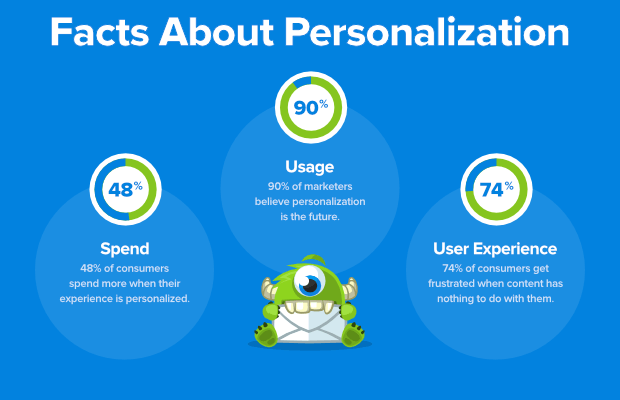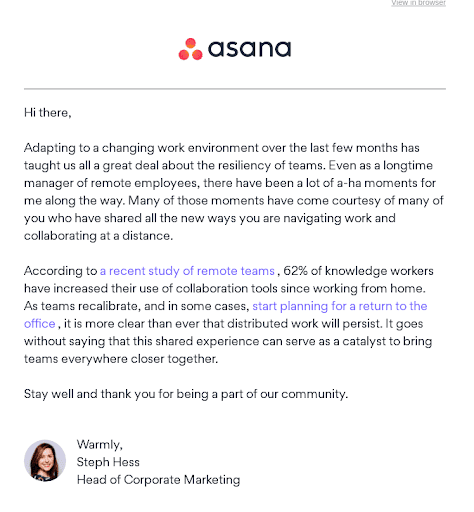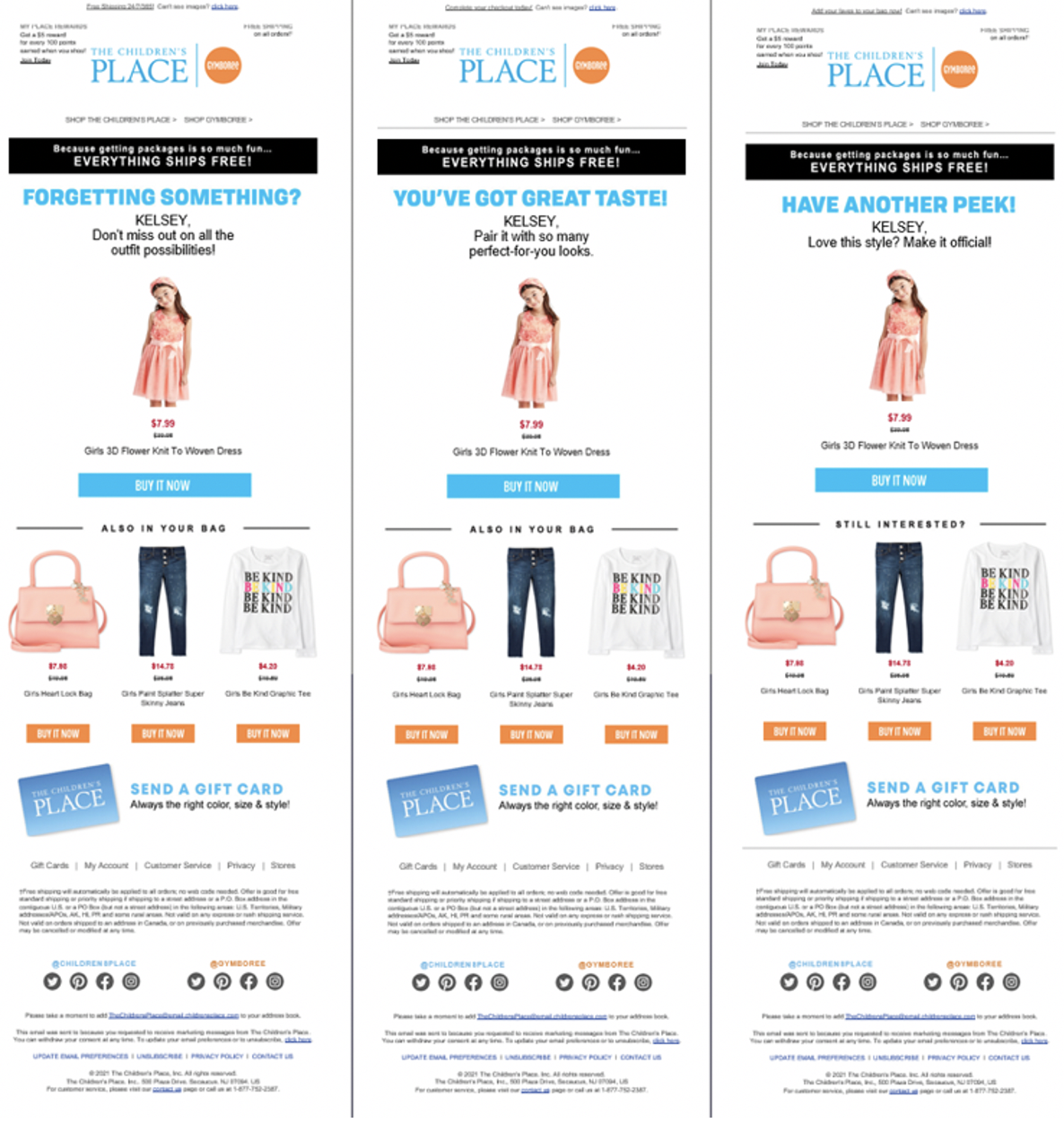Email marketing has never been the easiest marketing endeavor. There are many pitfalls to avoid, from customer data mismanagement to email writing mistakes and everything in between. Many recipients still distrust or simply ignore marketing emails, and their inboxes become more crowded every day. And yet, email continues to boast tremendous Return on Investment (ROI) and still offers an excellent lead acquisition tool. As such, email marketing deserves every business’s attention – and so does personalization, its rightful mainstay quality. To elaborate, let us explore email personalization trends to help you fine-tune your campaigns.
Why does email personalization matter?
On its own, this question doesn’t really hold value for many readers. Personalization is indeed a mainstay, in email marketing and otherwise, and countless studies have proven its benefits. These span across open rates, click-through rates, customer experience and retention, and even individual sales value:
A more appropriate question is why email personalization holds greater significance currently and in the years to come. Here, too, we may pinpoint some noteworthy developments on top of the above:
- Customers increasingly expect it. As inboxes become flooded, as Statista finds, personalization will largely inform if an email ever gets opened.
- GDPR compliance drives customer expectations. Many recipients still don’t trust businesses with their data, and personalization explicitly offers to help inspire confidence and build trust.
- Tracking is getting harder. As if browsers disabling third-party cookies weren’t enough, Apple’s new policy update also presents new challenges for email marketers – making personalization imperative.
In brief, email marketing is indeed becoming more complex, and personalization continues to offer a helping hand in meeting these challenges.
Email personalization trends
With this context in mind, let us delve into specific email personalization trends. For the sake of text economy, we’ll focus on the 6 primary ones here and leave adjacent secondary ones for inquisitive readers to discover.
#1 Start with a robust email list
First and foremost, personalization always begins with a robust email list. It will affect lead quality, open rates, and more, and it significantly overlaps with recipient confidence. You will thus need to invest time in creating it and, most importantly, ensure consent. Put simply, would you trust or even open emails from senders you don’t know or don’t care about? Most probably not.
Some fundamental pointers toward this crucial step include:
- Amp up your lead generation efforts. Fine-tune your social media activities, landing pages, and other lead generation practices to generate more valuable leads. Those are the leads that will typically be ripe for outreach after just a few touchpoints.
- Give your leads time to opt in. Speaking of, don’t immediately ask your leads to opt in. Instead, integrate such CTAs into a customer journey. For example, you may offer the option after they’ve completed a purchase or quiz.
- Never buy email lists. Finally, although it’s hopefully common knowledge, never buy email lists. They’re simply not worth it; legalities aside, these recipients have not given consent and won’t welcome unsolicited outreach.
#2 Engage in customer journey mapping
For that matter, customer journey mapping itself will likely continue to dominate email personalization trends. As businesses expand into omnichannel strategies and personalization becomes an imperative, customer journey mapping increasingly earns its place as a marketing staple.
A clear overview of the overall customer journey also offers notable benefits for email marketers, of course, including:
- Lead nurturing. Such software as CRM offers lead scoring capabilities, which can inform email outreach for optimal results.
- Timing optimizations. Lead status aside, the time of day also plays a crucial role toward personalization.
- Retention. Finally, identifying shortcomings throughout the journey and pain points post-purchase can directly inform email copy to enhance retention rates.
#3 Use BIMI
Speaking of your email itself, Brand Indicators for Message Identification (BIMI) will also substantially influence email marketing. This fancy acronym simply entails using recognizable brand logos to help incite trust and improve open rates:
This aligns with what we dubbed “inbox looks” in a previous article, which also includes:
- The sender name
- Subject lines
- Preheaders
In supporting email clients, BIMI acts as an additional reassurance that the email is actually relevant to the recipient. It serves as a visual element that can leverage brand recognition and stands out more than plain text. In other words, it enhances personalization before the email is even opened, with minimal effort on the marketer’s part.
#4 Opt for minimalism and simplicity – where appropriate
Another mainstay for email personalization trends lies in minimalism. You’ve likely seen this trend take hold in web design, from landing pages to product pages and blog content. Well, the same principles apply to email marketing – but personalization too must follow suit.
In general, minimalism in email bodies does promise better results. Cluttered inboxes and ample promotional noise leave recipients with little patience and short attention spans. In turn, simplicity offers such perks as:
- A clear course of action – recipients readily understand their options.
- Preventing choice fatigue – few, laser-focused CTAs prevent choice fatigue that may discourage conversions.
- Higher readability – especially on mobile devices, less visual clutter simply makes emails more digestible.
For a clear, text-based example of the latter, you may consider the following email by Asana:
However, what bears noting here is that too much simplicity may not resonate with all audiences. Some, such as younger demographics, may prefer some flair. Thus, you may generally embrace simplicity but still adjust depending on each segment’s expectations.
#5 Leverage interactive content
Similarly, interactive content continues to gain prominence, from animated social media posts to marketing gamification. The same applies to email marketing, especially in tandem with the above.
Consider such emerging trends you may further personalize emails through as:
- Animated CTAs to landing pages for lead acquisition
- User-generated content (UGC) to build trust with existing leads
- Slideshows of products for cross-sell opportunities
Of course, should it fit your brand, you may simply start with quizzes and surveys and then expand accordingly. Those tried-and-true types of interactive content alone can help refine your customer journey maps, acquire feedback on your general online presence, and offer a more fun experience for your existing and potential customers
#6 Employ behavioral messaging
Finally, as your grasp on your customers’ needs and journeys becomes more firm, email personalization trends highlight behavioral messaging as the next step.
Should you be using CRM or similar email automation software, you’re likely well aware of event triggers. These trigger specific email outreach when the user takes specific actions to maximize timing efficiency and achieve deeper personalization. Behavioral messaging closely follows this practice by tailoring messaging to specific behavior patterns.
For a visual example of this, consider the following by The Children’s Place:
As you can see, such messaging can truly complement your user’s experience. On their end, they’ll receive meaningful communication relevant to their desires and actions. On yours, it can offer such benefits as:
- Reduced cart abandonment rates through reminder emails
- Follow-ups for incomplete purchases
- Relevant product suggestions for cross-sell and upsell opportunities
In all cases, nothing says “personalization” quite like such well-tailored communication.
Summing up
In summary, email marketing remains an incredibly potent means of marketing. However, it’s becoming increasingly challenging and already almost necessitates deep personalization for optimal results. Email personalization trends seem to suggest that robust email lists, customer journey mapping, BIMI, design simplicity, interactive content, and behavioral messaging will only become more valuable and effective over time. While by no means exhaustive, hopefully this article helped you prepare and fine-tune your campaigns for the future.
About the author
Margery Andrews is a freelance copywriter and web designer. As a digital marketing enthusiast, she holds a deep interest in most things marketing, from SEO and PPC to CRM and email automation software. In her free time, she enjoys watching old stand-up shows and nature documentaries.




